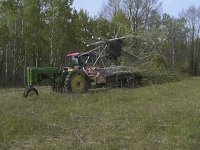Henro
Super Member
- Joined
- Jul 4, 2003
- Messages
- 5,004
- Location
- Few miles north of Pgh, PA
- Tractor
- Kubota B2910, BX2200, KX41-2V mini EX
Steve,
They way you have drawn it is the way I see it.
In a perfect world there would be no pressure at point "AA" that is true.
However, in the "real" world, there is resistance to flow encountered even in a straight pipe. Such resistance to flow in a circuit like in a tractor's open center loop, will without question result in back pressure in the loop that the fluid flows through. This pressure would be max at closest to the pump, and zero at the hydraulic tank.
The fact that we live in the real world is why the CC valve that shunts (parallels) can actually supply some pressure to work a cylinder. The question is not whether there is pressure at point AA, but rather how much. JerryG in another thread has reported seeing system pressures of about 100 to 200 psi with nothing operating. I don't think anyone else has reported an actual measurement. My gut says Jerryg's report is reasonable. I wish I had a means at hand to make a measurement myself.
No doubt in my mind that this is truly the way things are... /forums/images/graemlins/smile.gif
Actually, now that I see how things are working, I think this is a pretty clever application of a closed circuit valve. /forums/images/graemlins/smile.gif
When one of the OC valves that are in the circuit are operated, the pressure at point AA will rise, up to the pressure at which the system PRV pops if that point is reached, like when a loader treaches limit of travel, for example.
Hope this makes sense to someone other than me! /forums/images/graemlins/crazy.gif
They way you have drawn it is the way I see it.
In a perfect world there would be no pressure at point "AA" that is true.
However, in the "real" world, there is resistance to flow encountered even in a straight pipe. Such resistance to flow in a circuit like in a tractor's open center loop, will without question result in back pressure in the loop that the fluid flows through. This pressure would be max at closest to the pump, and zero at the hydraulic tank.
The fact that we live in the real world is why the CC valve that shunts (parallels) can actually supply some pressure to work a cylinder. The question is not whether there is pressure at point AA, but rather how much. JerryG in another thread has reported seeing system pressures of about 100 to 200 psi with nothing operating. I don't think anyone else has reported an actual measurement. My gut says Jerryg's report is reasonable. I wish I had a means at hand to make a measurement myself.
No doubt in my mind that this is truly the way things are... /forums/images/graemlins/smile.gif
Actually, now that I see how things are working, I think this is a pretty clever application of a closed circuit valve. /forums/images/graemlins/smile.gif
When one of the OC valves that are in the circuit are operated, the pressure at point AA will rise, up to the pressure at which the system PRV pops if that point is reached, like when a loader treaches limit of travel, for example.
Hope this makes sense to someone other than me! /forums/images/graemlins/crazy.gif


